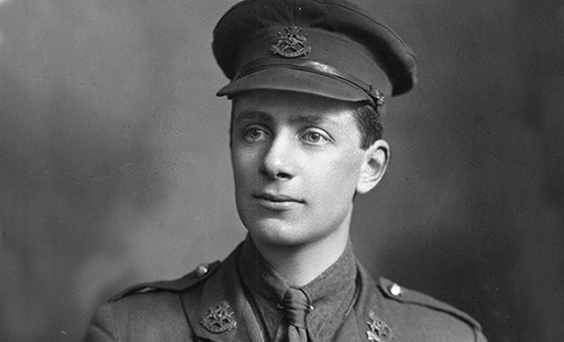04 October 2018
Nottingham First World War hero remembered

To mark the end of the First World War Centenary, the Commonwealth War Graves Commission (CWGC) has launched its “Road to Peace” project. The project tells 120 personal stories of casualties who died during the final 100 days of the First World War, from 8 August to 11 November.
The stories have been compiled by the CWGC’s team of historians and includes the remarkable account of a First World War Hero from Nottingham. Maxwell fought in many of the major battles on the Western Front during 1918, including the Battle of St Quentin Canal, where he was awarded the Military Medal.
Born in 1898, in Nottingham, Maxwell was educated at St. Edmund’s School in Hindhead, Surrey. In 1916, he was studying at Oxford University when he received a commission as a Second Lieutenant and at the age 19 he joined the Army.
He arrived in France on 11 September 1917 and joined the 1st/5th Battalion of the Sherwood Foresters, part of the 46th (North Midland) Division. Through the autumn and winter of 1917-18 Maxwell learned the business of fighting on the Western Front.
During the 100 Days Offensive, the 46th Division played a key part in breaking through the formidable German ‘Hindenburg Line’ defensive positions, which included huge belts of barbed wire, deep trenches and steel-reinforced concrete fortifications built around the St Quentin Canal.
On 24 September 1918, Maxwell took part in attack on the outer defenses of the Hindenburg Line, near the French village of Berthaucourt. It was Maxwell’s actions here that earnt him the Military Cross:
At Berthaucourt…during a successful attack when platoons of another company had been held up, he led his platoon forward under heavy machine-gun fire. It was largely due to his courage, initiative and fine leadership displayed at a very critical moment that a series of very strong machine-gun posts were able to be carried and a large number of prisoners taken.’
Just a few weeks later on 3 October, as Maxwell’s unit pushed the Germans back still further, he was killed. He was just 20 years old.
Maxwell is buried not far from where he fell, at CWGC Bellicourt British Cemetery in France. Upon his headstone are inscribed the words “The beloved only son of George and Margeurite Barrows, Nottingham”.
The Road to Peace Project aims to illustrate the global nature of sacrifice of the First World War. From famous casualties like war poet Wilfred Owen, through to relatively unknown individuals; from those dying in battle to those who died of Spanish Flu; each story has been carefully chosen to shine a light on the human stories on the costly Road to Peace.
CWGC Historian, Max Dutton, explained: “Behind every one of our headstones or names on a memorial to the missing, is a human story just waiting to be told. Our 100 days “Road to Peace” campaign will remind people of the human cost of the Great War, the sheer diversity of those who took part and the global nature of that sacrifice and remembrance today. We hope Lieutenant Maxwell’s story will inspire people to find out more about him and his comrades commemorated by the CWGC and visit their graves and memorials.”
From 8 August – the 100th anniversary of the Allied victory at the Battle of Amiens – the “Road to Peace” campaign will conclude on 11 November with the stories of 11 people who died on the very last day of the First World War, even as the guns fell silent. The “100 Days” is a term applied to the final period of the First World War, during which the Allies launched a series of offensives on the Western Front that ultimately led to peace. Not actually 100 calendar days, the term is a reference to the final period of the Napoleonic Wars.
The Road to Peace stories will be shared across the CWGC’s digital channels on Facebook, Twitter and Instagram. A story will appear every day – with a more in-depth feature appearing weekly.

